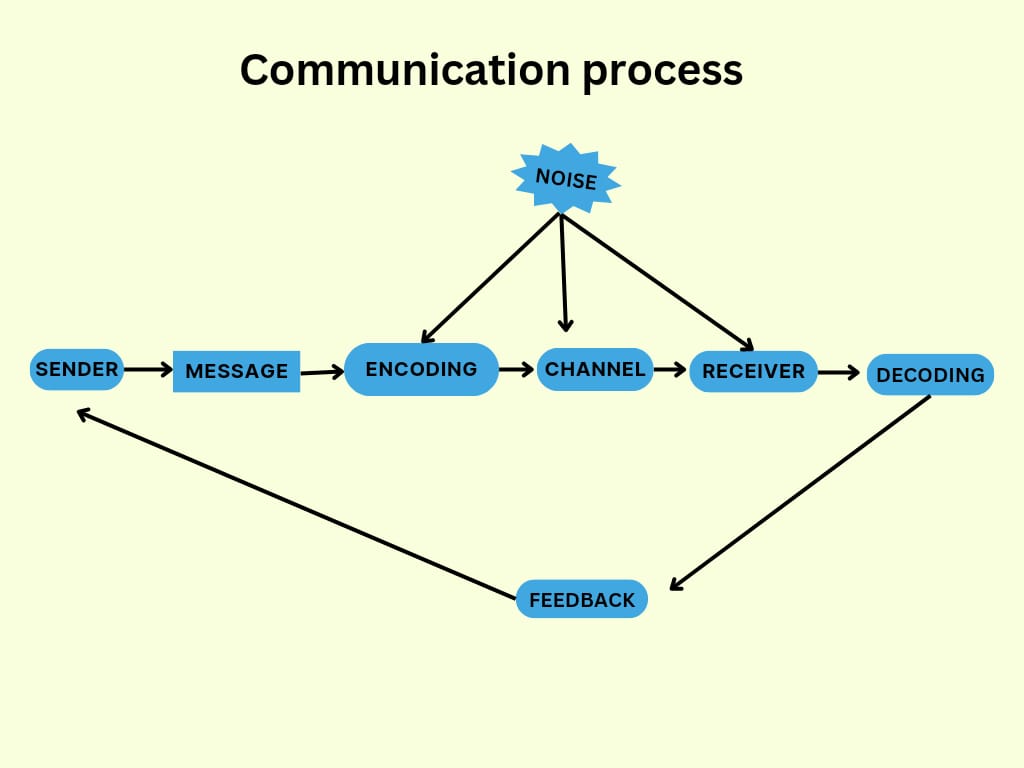Communication Process.
The communication process typically involves a sender, a message, a medium or channel, a receiver, and feedback. The sender encodes a message, transmits it through a chosen medium, the receiver decodes it, and may provide feedback to complete the process. Effective communication requires clarity and understanding between all parties involved.
COMMUNICATION
11/2/20232 min read


Communication Process.
The communication process typically involves a sender, a message, a medium or channel, a receiver, and feedback. The sender encodes a message, transmits it through a chosen medium, the receiver decodes it, and may provide feedback to complete the process. Effective communication requires clarity and understanding between all parties involved.
Communication is a fundamental aspect of human interaction, and its effectiveness is crucial in various contexts, from personal relationships to business transactions. The communication process involves several key elements. Certainly, let's look into a more detailed breakdown of the communication process:
Sender:
The process begins with a sender who has a message to convey. The sender initiates communication by encoding their thoughts, feelings, or information into a message they want to convey to the receiver.
Message:
The message is the information or content the sender wishes to communicate. It can take various forms, such as verbal, written, or non-verbal communication like body language and gestures.
Encoding:
Before transmitting the message, the sender encodes it. This involves organizing thoughts and ideas into a format that can be effectively communicated. This step involves the sender choosing words, symbols, or other means to transform their thoughts and ideas into a format that can be easily transmitted to the receiver.
Medium or Channel:
The sender selects a medium or channel through which to send the message. This could be face-to-face conversation, phone calls, emails, text messages, social media, or other communication tools.
Receiver:
The receiver is the individual or group intended to receive the message. They play a crucial role in the communication process as they are responsible for interpreting the message.
Decoding:
Upon receiving the message, the receiver decodes it by interpreting the content and trying to understand the sender's intended meaning. This process involves comprehension and analysis.
Receiver's Response:
After decoding the message, the receiver may formulate a response or take action based on the message they received. This response can be verbal or non-verbal and initiates a new cycle of communication if necessary.
Feedback:
Effective communication often involves a feedback loop. The receiver provides feedback to the sender, indicating their understanding or seeking clarification. This step helps ensure that the message was received and interpreted correctly. Effective communication often involves a continuous feedback loop, where both the sender and receiver engage in ongoing dialogue, adjusting their communication as needed to ensure mutual understanding.
Noise:
Noise refers to any interference or distortion that can disrupt the communication process. It can be external (e.g., background noise) or internal (e.g., biases, distractions or misinterpretations) and can affect the clarity and accuracy of the message.
Context:
The context of communication includes the surrounding circumstances and factors that influence the interpretation of the message. Context can encompass the relationship between sender and receiver, cultural norms, and the timing of the communication.
Barriers:
Communication barriers are obstacles that can hinder effective communication. These barriers may include language differences, misinterpretation, emotional barriers, or physical barriers like distance or technology issues.
In summary, the communication process is a complex and dynamic exchange of information between a sender and receiver, influenced by various factors such as encoding, decoding, feedback, noise, and the surrounding context. Effective communication requires careful consideration of each step and active efforts to overcome barriers to understanding.
© 2025 Copyright Amna Sadaf
